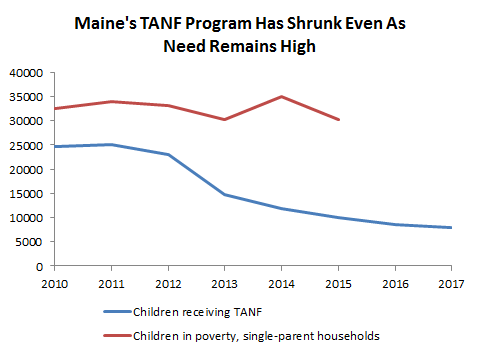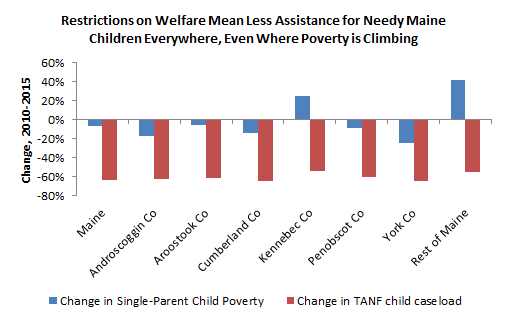For several years now, Maine’s approach to child poverty has effectively been to ignore it. Federal money earmarked for specific purpose of addressing this problem has been left untouched while tens of thousands of children struggle without enough food to eat, a stable place to live, and just one incident away from family catastrophe. Maine can, and must do better. I urge the committee to pass this legislation as a means of enacting real reform in Maine’s welfare system.
Good afternoon, Senator Brakey, Representative Hymanson, and members of the Joint Committee on Health and Human Services. My name is James Myall. I am a policy analyst at the Maine Center for Economic Policy, and I am here to testify in support of LD1475, “An Act to Reduce Child Poverty by Leveraging Investments in Families Today.” We believe that the strength of Maine’s economy is dependent on the ability of all residents to participate and thrive, and that ensuring that Mainers in poverty have routes to employment is critical to an economy that works for everyone. For welfare programs to be successful, they must provide routes out of poverty and into employment or education, and the legislation before you does so in a number of ways.
Let me begin by acknowledging the negative effect that recent changes to the Maine’s Temporary Assistance for Needy Families (TANF) program have had. In 2010, at the bottom of the Great Recession, more than one in three Maine children in single-parent households (36%) were living in poverty. Five years later, after a series of “reforms” by this administration, that figure had not changed.[1] There are still 30,000 Maine children with single parents who are living in poverty, yet the number who qualify for much-needed financial assistance is just one quarter what it was in 2010.[2] In parts of the state, the number of these children in poverty was even higher than it had been in 2010, even as fewer were qualifying for TANF. In short, Maine has turned its back on its neediest citizens.

Source: MECEP analysis of Maine Department of Health and Human Services data and US Census Bureau, American Community Survey, 2010-2015 1-year estimates. 
Source: MECEP analysis of Maine Department of Health and Human Services data and US Census Bureau, American Community Survey, 2010-2015 1-year estimates.
The way to tackle poverty is not to ignore it, but to provide routes out and into employment and training. This legislation takes tens of millions of dollars sequestered by the administration and puts them to work to address some of the many barriers faced by parents and children in poverty. A study by the federal Department of Health and Human Services found that 40% of TANF recipients had less than a high school education, one in five had little or no work experience, and significant numbers had health concerns. Another study found that 5% of TANF recipients had no car and no access to public transportation. Most TANF families report struggling with not just one, but many, barriers to work.[3] This bill would help families overcome these obstacles by providing access to education, affordable car ownership, child care, and stable housing.
The legislation will also address structural deficiencies in the current TANF program, by addressing the increased cost of living since the program’s inception, and by mitigating the so-called “welfare cliff” that forces families to make the false choice between keeping crucial assistance and getting a job. In 1992, a loaf of bread cost 73 cents; a dozen eggs were less than a dollar, and heating oil was $1 a gallon.[4] Good luck finding those prices today. But families on TANF have had to stretch their limited benefit further and further each year, as its value is eroded by inflation. We wouldn’t stand for Social Security recipients being disadvantaged in this way, nor should we for children in poverty.
Nobody wants to be enrolled in the TANF program in perpetuity. Parents would much rather be in employment or training, to be providing for their families. The hard reality, however, is that for those families hovering on the upper limit of the program, program rules work against them. When taking a job means less money to feed your children, it’s no surprise that some parents feel trapped in an impossible situation. Maine families shouldn’t have to make that choice. This legislation takes a commonsense approach to addressing this problem, by increasing the amount of the State Earned Income Tax Credit (EITC) for the lowest-income working families. This lessons the financial impact of losing TANF support when starting work, and replaces welfare support with support from the Earned Income Tax Credit. The EITC is widely acknowledged by both progressive and conservative economists to be one of the most effective means of addressing poverty and the proposed increase would have a dramatic impact on the lives of tens of thousands of Maine children.
Finally, we would like to commend this legislation for its commitment to accountability and measurable outcomes. No one wants to see public funds misused, and it is important for us to know how effective these new measures will be. Maine currently does little to nothing to ensure that our neediest families are receiving the support they need, and that they are indeed able to work towards a better life. The provisions that establish benchmarks with legislative oversight in this legislation are therefore welcome.
For several years now, Maine’s approach to child poverty has effectively been to ignore it. Federal money earmarked for specific purpose of addressing this problem has been left untouched while tens of thousands of children struggle without enough food to eat, a stable place to live, and just one incident away from family catastrophe. Maine can, and must do better. I urge the committee to pass this legislation as a means of enacting real reform in Maine’s welfare system.
Thank you. I’ll be happy to take any questions.
Notes
[1] US Census Bureau, American Community Survey, 1-year estimates, 2010 and 2015.
[2] Maine Department of Health and Human Services data, children receiving TANF in December 2010 and April 2017.
[3] http://www.urban.org/research/publication/hard-employ-parents/view/full_report
[4] US Bureau of Labor Statistics, Consumer Price Index, Average Price data, 1992.
[pdf-embedder url=”https://www.mecep.org/wp-content/uploads/2017/05/LIFTtestimony.pdf”]


